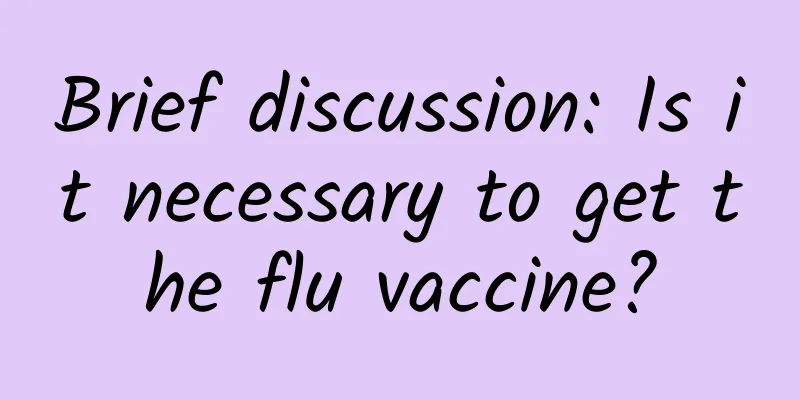Brief discussion: Is it necessary to get the flu vaccine?

|
Yesterday's article "Will the KP.2 variant strike with the flu?" explained why respiratory diseases have been rampant in the past year, making people exhausted. So the question is, facing the flu and the mutating new coronavirus, do we have no way to deal with it? In fact, these problems are not that complicated. Let's talk about them one by one today. 01. How to deal with the new coronavirus? In fact, we don’t have many methods for the new coronavirus at present, because the new coronavirus is a brand new virus. Although we have been exposed to the new coronavirus for the fourth year, we still know very little about it. Whether it is the prediction of the new coronavirus variant or the development of the new coronavirus vaccine itself, we are actually relatively backward. This leads to the fact that in the face of the new coronavirus, we can only respond passively at present, and can only respond according to symptoms. If you have common symptoms of new coronavirus infection such as sore throat, nasal congestion, runny nose, cough, fever, headache, change or loss of smell and taste, then you should seek medical attention in time. However, it is different with influenza. We have vaccines, and they are very mature, so we will focus on how to respond to influenza. 02. Why can influenza be predicted in advance? First, influenza can be predicted very well. You may also be curious, why do hospitals and disease control have special influenza vaccines every year? Isn't it said that influenza is always mutating? Is this vaccine still useful? The answer is of course, because this vaccine is newly produced for the current strain. Why can we predict this year's strain and produce a vaccine in advance? This has to be said that our understanding of influenza far exceeds that of many other viruses. Here’s a piece of trivia: Have you heard of the Spanish Flu? That super flu outbreak occurred between 1918 and 1919, infecting one-third of the world’s population and killing 50 million people worldwide. Some estimates put the death toll at hundreds of millions, making it one of the infectious diseases with the highest number of casualties to date [1]. In fact, this flu is not over. Almost all influenza A viruses today are descendants of the 1918 flu virus, including drifted H1N1, recombinant H2N2 and H3N2. It can be said that the 1918 flu pandemic is the mother of all flu viruses. It is precisely because of this huge casualties and the continuous and periodic appearance of influenza that scientists in related fields around the world continue to pay attention to and study influenza, and ultimately make great progress in the mechanism, prevention and drugs of influenza. Therefore, although influenza is still present today, we can already make predictions about it, and publish them in advance on an annual basis. For example, in February 2024, the World Health Organization released the recommended combination of influenza vaccines for the northern hemisphere in 2024-2025. This recommendation is based on the WHO's analysis and assessment of global influenza viruses. Every year, the WHO collaborates with national influenza centers and reference laboratories around the world to form a global influenza surveillance network, where laboratories and institutions around the world continuously collect and analyze influenza virus samples. Next, all collected influenza virus samples will be combined to analyze which strains are currently circulating, their genetic mutations, antigenic characteristics, and future developments. It is precisely because of this that we have sufficient response capabilities when influenza breaks out every year. This is also the main reason why, after the Spanish flu outbreak in 1918, although we have continued to face the challenge of the influenza virus, there has never been a large-scale outbreak of infection and casualties. However, for many people, they are not vigilant enough about influenza. This may be due to traditional cognition, which makes us always use the term "cold" to cover everything, or distinguish it into wind-cold and wind-heat colds which are more difficult to identify. In fact, in modern scientific knowledge, colds are not a single disease. At least they are divided into the common cold and influenza. This concept sometimes leads people to misunderstanding and confusion. In fact, if we describe them in English, it may be easy to see the difference. The common cold is called common cold, while influenza is called influenza (flu), which is obviously different. 03. The difference between influenza and the common cold For many people, the flu is not a serious problem and some even confuse it with the flu. In fact, there is a big difference between the two. Special reminder: Common cold medicines are ineffective against influenza. Influenza is a disease caused by a virus, and we need to use special medicines targeting the influenza virus to treat it. Not only that, the harm of influenza is much greater than that of the common cold. The ancestor of influenza was a virus with great lethality in the past. Even though it has weakened a little today, it is still highly infectious and toxic. Influenza can cause fever, body aches, and loss of appetite. Moreover, this virus is very harmful to people with weak immunity, such as infants, the elderly, pregnant women, and patients with chronic diseases. If it is not treated in time and the influenza is aggravated, it may cause a series of complications, the typical one being pneumonia. Other symptoms such as septic shock and viral myocarditis are also symptoms that influenza can easily cause. Today, there are still an average of 88,000 (95% CI: 84,000-92,000) excess deaths from influenza-related respiratory diseases in my country each year [3]. This serious consequence is worthy of great attention. So never underestimate the flu. 04. Are vaccines effective? Why do some people still catch a cold after getting vaccinated? The answer is of course yes. After decades of research, scientists in related fields around the world have finally made great progress in the mechanism, prevention and medicine of influenza, and now have mastered the scientific response skills. The principles of influenza vaccines are similar to those of other vaccines. After vaccination, the body can produce specific immunity against the virus in advance. In this way, when the real influenza virus attacks, the body will quickly produce antibodies and other specific immunity to respond to the invasion of the influenza virus, thus protecting people from harm by the influenza virus. Every year, the World Health Organization collaborates with national influenza centers and reference laboratories around the world to form a global influenza surveillance network. Laboratories and institutions around the world continuously collect and analyze influenza virus samples to see their genetic mutations, antigenic characteristics, and future developments. Based on comprehensive and multiple data analysis, the next popular virus is given. For example, the strains that will be prevalent in 2024-2025 are as follows: Then, we instruct local areas to develop corresponding vaccines based on these strains, such as chicken embryo culture-based, cell culture-based and recombinant influenza vaccines, so as to supply vaccines in time before an influenza virus outbreak. In addition to the scientific nature of the vaccine itself, correct vaccination can only be "useful". Because the influenza virus is constantly changing and there is no cross-immunity, the vaccine injected last year will not be effective against this year's influenza, so it is necessary to inject the vaccine for the corresponding strain every year, and it is not a one-time solution. Usually, protective antibodies can be produced 2 to 4 weeks after the flu vaccine is administered. Therefore, we can work backwards and get the flu vaccine at least 2 to 4 weeks before the flu season arrives, so as to better protect our health. Of course, there is another situation. Sometimes other respiratory diseases may be misdiagnosed as influenza, especially during the flu season, such as bacterial infections, mycoplasma infections, etc. After all, many times, people tend to judge based on symptoms rather than doing relevant pathogen tests. In fact, a large number of studies have shown that influenza vaccines can significantly improve people's ability to protect themselves. For example, the chance of getting the flu after receiving the flu vaccine is only one-third of that of people who have not been vaccinated. Even if you are infected with the flu, it can significantly reduce the symptoms of the flu and reduce the use of related drugs. [2] It is particularly worth mentioning that for children and the elderly who are susceptible to the flu, the effect of the flu vaccine is more obvious and can significantly reduce the rate of flu-related hospitalizations. Therefore, although the flu vaccine may not completely prevent the flu, it is recommended by the WHO, European and American countries, and my country because it can alleviate the disease, reduce the risk of hospitalization and flu-related deaths. Especially for the elderly, children, and pregnant women, these special groups are most in need of flu vaccination. 05. Does the flu vaccine have any side effects? Some netizens also said, "Is the flu vaccine safe? I'm afraid of side effects." In fact, there is no need to worry about this. Flu vaccines are vaccines with a long history and mature technology. Since the first flu vaccine was developed in 1935, scientists have continuously improved flu vaccines. Now there are multivalent vaccines and multiple vaccines with different production methods to choose from. Moreover, after long-term improvements, the safety of vaccines has been greatly improved, so there is no need to worry. Even if there are occasional side effects, they are basically mild and self-limiting, and usually disappear within 1 to 2 days. 06. How to choose a vaccine? First of all, from the perspective of price, it can be divided into trivalent and quadrivalent. The quadrivalent vaccine has one more strain of influenza B than the trivalent vaccine, which can provide one more defense, so the quadrivalent vaccine is more recommended. According to the process, it is divided into whole virus inactivated vaccine, split vaccine and subunit vaccine. You can choose according to your personal situation. For example, if you require strong immunogenicity, then the inactivated vaccine is preferred. As for choosing imported or domestic products, it is recommended that you make your choice based on your personal financial strength and regional supply conditions. However, in general, vaccination is much easier than going to the hospital to queue up after getting the flu. Even if you consider the cost alone, the flu vaccine is much cheaper than going to the outpatient clinic or even hospitalization for the flu. Moreover, the channels for appointment and vaccination are now very rich and convenient. You can make an appointment on your mobile phone + community clinic in a few simple steps. So, no matter what new tricks the flu comes up with, remember to make an appointment in advance for yourself and your family and get the flu vaccine in time. This is the wisest way to deal with it. 1. Taubenberger, Jeffery K., and David M. Morens. "1918 Influenza: the mother of all pandemics." Revista Biomedica 17, no. 1 (2006): 69-79. 2. Zhang Xiang, He Yilin, and Yang Haiyu. "Study on the immune effects of influenza A (H1N1) vaccine and seasonal influenza vaccine." Chinese Journal of Disease Control 16, no. 5 (2012): 452-454. 3. Li, Li, Yunning Liu, Peng Wu, Zhibin Peng, Xiling Wang, Tao Chen, Jessica YT Wong et al. "Influenza-associated excess respiratory mortality in China, 2010–15: a population-based study." The Lancet Public Health 4, no. 9 (2019): e473-e481. |
<<: Frequent thirst can lead to illness, so drinking more water is better, especially in summer?
Recommend
What brand is the same large row of lights as Zhang Tianai? How much is the same large row of lights as Zhang Tianai?
Recently, the variety show "Oh My Good Body&...
How many months of pregnancy do you not need to take folic acid?
In the early stages of pregnancy, you should supp...
Do I need to wash off the vitamin E I put on my face?
We all know that vitamin E has antioxidant and sk...
What causes leucorrhea and abdominal distension and pain?
Excessive leucorrhea and lower abdominal distensi...
Is breast augmentation harmful to the body?
Today's living conditions are getting better ...
Brown discharge during early pregnancy
Pregnant women in the early stages of pregnancy s...
Vaginitis is the nightmare of all women? Don’t be afraid, nightmares will eventually be “defeated”
Vaginitis, as the most common gynecological disea...
Why does the vagina smell fishy?
Because of the special structure of female reprod...
Beware of the four most dangerous types of dysmenorrhea
Dysmenorrhea can be divided into primary dysmenor...
[Health Lecture] How do kidney patients on dialysis spend the winter?
As the winter cold wave arrives, the temperature ...
What to do if leg joints hurt after giving birth
Many mothers do not take good care of their bodie...
My period is not coming and I have stomach pain
Recently, everyone is very worried about the mens...
Brown discharge in 4 months of pregnancy
If a pregnant woman has brown discharge when she ...
The difference between iodine water contrast and iodine oil contrast
In daily life, women are the main actors, because...
How long does a course of chemotherapy for breast cancer last?
Breast cancer patients need to pay attention to p...









